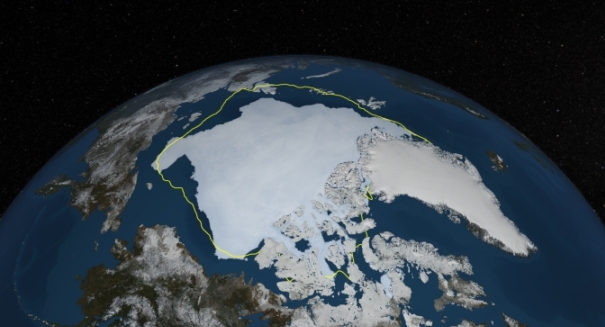
A late start to warmer weather this year resulted in overall less melt.
Citing the National Snow and Ice Data Center (NSIDC), NASA reports that the Arctic sea ice achieved its annual minimum summer extent for 2013 on Friday, September 13. The sea ice extent diminished to 1.97 million square miles.
Last year, however, Arctic sea ice achieved its smallest extent every documented by satellites at 1.32 million square miles.
This year’s minimum is the sixth lowest extent of the satellite record and is 432,000 lower than the 1981-2010 average. According to NASA, this is approximately the size of Texas and California combined.
The space agency adds that the 2013 Arctic sea ice minimum fits with the long-term downward trend of approximately 12 percent per decade since the late 1970s. This year’s bounce back from 2012 did not surprise scientists.
“I was expecting that this year would be higher than last year,” posited Walt Meier, a glaciologist at NASA’s Goddard Space Flight Center. “There is always a tendency to have an uptick after an extreme low; in our satellite data, the Arctic sea ice has never set record low minimums in consecutive years.”
According to NASA, the ice cap covering the Arctic Ocean melts in the summer and refreezes in the winter. A late start to warmer weather this year resulted in overall less melt.
In 2013, Arctic temperatures were 1.8 to 4.5 degree Fahrenheit cooler than average. The colder temperatures were in a part a result of a series of summer cyclones. Under cloudier conditions, surface winds moved the ice over a larger area.
“The trend with decreasing sea ice is having a high-pressure area in the center of the Arctic, which compresses the ice pack into a smaller area and also results in clear skies, which enhances melting due to the sun,” said Richard Cullather, an atmospheric scientist at Goddard. “This year, there was low pressure, so the cloudiness and the winds associated with the cyclones expanded the ice.”
According to the space agency, Arctic sea ice cover is a lot thinner on average than it was decades ago. In fact, Arctic sea ice thickness is up to 50 percent thinner that it was in previous decades. Arctic sea ice has an average thickness of 6.2 feet in recent years.
According to Joey Comiso, a scientist at Goddard, thinner ice melts at a much quicker rate than thicker ice does. He predicted that the Arctic’s summer sea ice will “completely disappear within this century.”
Leave a Reply